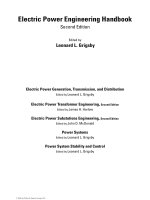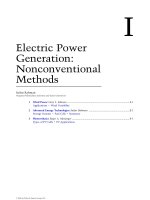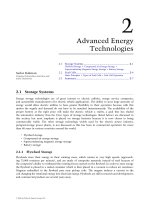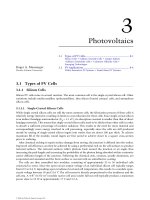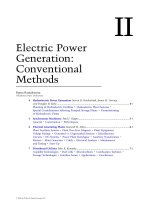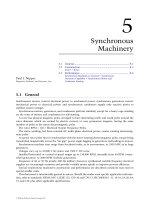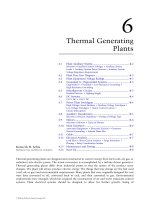power system stability and control chuong (3)
Bạn đang xem bản rút gọn của tài liệu. Xem và tải ngay bản đầy đủ của tài liệu tại đây (79.95 KB, 10 trang )
I
Electric Power
Generation:
Nonconventional
Methods
Saifur Rahman
Virginia Polytechnic Institute and State University
1 Wind Power Gary L. Johnson 1-1
Applications
.
Wind Variability
2 Advanced Energy Technologies Saifur Rahman 2-1
Storage Systems
.
Fuel Cells
.
Summary
3 Photovoltaics Roger A. Messenger 3-1
Types of PV Cells
.
PV Applications
ß 2006 by Taylor & Francis Group, LLC.
ß 2006 by Taylor & Francis Group, LLC.
1
Wind Power
Gary L. Johnson
Kansas State University
1.1 Applications 1-2
Small, Non-Grid Connected
.
Small, Grid Connected
.
Large, Non-Grid Connected
.
Large, Grid Connected
1.2 Wind Variability 1-4
Land Rights
The wind is a free, clean, and inexhaustible energy source. It has served humankind well for many
centuries by propelling ships and driving wind turbines to grind grain and pump water. Denmark was
the first country to use wind for generation of electricity. The Danes were using a 23-m diameter wind
turbine in 1890 to generate electricit y. By 1910, several hundred units with capacities of 5 to 25 kW were
in operation in Denmark (Johnson, 1985). By about 1925, commercial wind-electric plants using two-
and three-bladed propellers appeared on the American market. The most common brands were
Wincharger (200 to 1200 W) and Jacobs (1.5 to 3 kW). These were used on farms to charge storage
batteries which were then used to operate radios, lights, and small appliances with voltage ratings of 12,
32, or 110 volts. A good selection of 32-VDC appliances was developed by the industry to meet this
demand.
In addition to home wind-electric generation, a number of utilities around the world have built
larger wind turbines to supply power to their customers. The largest wind turbine built before the late
1970s was a 1250-kW machine built on Grandpa’s Knob, near Rutland, Vermont, in 1941. This turbine,
called the Smith-Putnam machine, had a tower that was 34 m high and a rotor 53 m in diameter. The
rotor turned an ac synchronous generator that produced 1250 kW of electrical power at wind speeds
above 13 m=s.
After World War II, we entered the era of cheap oil imported from the Middle East. Interest in wind
energy died and companies making small turbines folded. The oil embargo of 1973 served as a wakeup
call, and oil-importing nations around the world started looking at wind again. The two most important
countries in wind power development since then have been the U.S. and Denmark (Brower et al., 1993).
The U.S. immediately started to develop utility-scale turbines. It was understood that large turbines
had the potential for producing cheaper electricity than smaller turbines, so that was a reasonable
decision. The strategy of getting large turbines in place was poorly chosen, however. The Department of
Energy decided that only large aerospace companies had the manufacturing and engineering capability
to build utility-scale turbines. This meant that small companies with good ideas would not have the
revenue stream necessary for survival. The problem with the aerospace firms was that they had no desire
to manufacture utility-scale wind turbines. They gladly took the government’s money to build test
turbines, but when the money ran out, they were looking for other research projects. The government
funded a number of test turbines, from the 100 kW MOD-0 to the 2500 kW MOD-2. These ran for brief
periods of time, a few years at most. Once it was obvious that a particular design would never be cost
competitive, the turbine was quickly salvaged.
Denmark, on the other hand, established a plan whereby a landowner could buy a turbine and sell the
electricity to the local utility at a price where there was at least some hope of making money. The early
ß 2006 by Taylor & Francis Group, LLC.
turbines were larger than what a farmer would need for himself, but not what we would consider utility
scale. This provided a revenue stream for small companies. They could try new ideas and learn from
their mistakes. Many people jumped into this new market. In 1986, there were 25 wind turbine
manufacturers in Denmark. The Danish market gave them a base from which they could also sell to
other countries. It was said that Denmark led the world in exports of two products: wind turbines and
butter cookies! There has been consolidation in the Danish industry since 1986, but some of the
companies have grown large. Vestas, for example, has more installed wind turbine capacity worldwide
than any other manufacturer.
Prices have dropped substantially since 1973, as performance has improved. It is now commonplace
for wind power plants (collections of utility-scale turbines) to be able to sell electricity for under four
cents per kilowatt hour.
Total installed worldwide capacity at the start of 1999 was almost 10,000 MW, according to the trade
magazine Wind Power Monthly (1999). The countries with over 50 MW of installed capacity at that time
are shown in Table 1.1.
1.1 Applications
There are perhaps four distinct categories of wind power which should be discussed. These are
1. small, non-grid connected
2. small, grid connected
3. large, non-grid connected
4. large, grid connected
By small, we mean a size appropriate for an individual to own, up to a few tens of kilowatts. Large refers
to utility scale.
1.1.1 Small, Non-Grid Connected
If one wants electricity in a location not serviced by a utility, one of the options is a wind turbine, with
batteries to level out supply and demand. This might be a vacation home, a remote antenna and
transmitter site, or a Third-World village. The costs will be high, on the order of $0.50=kWh, but if the
total energy usage is small, this might be acceptable. The alternatives, photovoltaics, microhydro, and
diesel generators, are not cheap either, so a careful economic study needs to be done for each situation.
TABLE 1.1 Wind Power Installed Capacity
Canada 83
China 224
Denmark 1450
India 968
Ireland 63
Italy 180
Germany 2874
Netherlands 363
Portugal 60
Spain 834
Sweden 150
U.K. 334
U.S. 1952
Other 304
Total 9839
ß 2006 by Taylor & Francis Group, LLC.
1.1.2 Small, Grid Connected
The small, grid connected turbine is usually not economically feasible. The cost of wind-generated
electricity isless because the utility is usedfor storage rather than a battery bank, but isstill not competitive.
In order for the small, grid connected turbine to have any hope of financial breakeven, the turbine
owner needs to get something close to the retail price for the wind-generated electricity. One way this is
done is for the owner to have an arrangement with the utility called net metering. With this system, the
meter runs backward when the turbine is generating more than the owner is consuming at the moment.
The owner pays a monthly charge for the wires to his home, but it is conceivable that the utility will
sometimes write a check to the owner at the end of the month, rather than the other way around. The
utilities do not like this arrangement. They want to buy at wholesale and sell at retail. They feel it is
unfair to be used as a storage system without remuneration.
For most of the twentieth century, utilities simply refused to connect the grid to wind turbines. The
utility had the right to generate electricity in a given service territory, and they would not tolerate
competition. Then a law was passed that utilities had to hook up wind turbines and pay them the avoided
cost for energy. Unless the state mandated net metering, the utility t ypically required the installation of a
second meter, one measuring energy consumption by the home and the other energy production by the
turbine. The owner would pay the regular retail rate, and the utility would pay their estimate of avoided
cost, usually the fuel cost of some base load generator. The owner might pay $0.08 to $0.15 per kWh, and
receive $0.02 per kWh for the wind-generated electricity. This was far from enough to economically
justify a wind turbine, and had the effect of killing the small wind turbine business.
1.1.3 Large, Non-Grid Connected
These machines would be installed on islands or in native villages in the far north where it is virtually
impossible to connect to a large grid. Such places are typically supplied by diesel generators, and have a
substantial cost just for the imported fuel. One or more wind turbines would be installed in parallel
with the diesel generators, and act as fuel savers when the wind was blowing.
This concept has been studied carefully and appears to be quite feasible technically. One would expect
the market to develop after a few turbines have been shown to work for an extended period in hostile
environments. It would be helpful if the diesel maintenance companies would also carry a line of wind
turbines so the people in remote locations would not need to teach another group of maintenance
people about the realities of life at places far away from the nearest hardware store.
1.1.4 Large, Grid Connected
We might ask if the utilities should be forced to buy wind-generated electricity from these small
machines at a premium price which reflects their environmental value. Many have argued this over
the years. A better question might be whether the small or the large turbines will result in a lower net
cost to society. Given that we want the environmental benefits of wind generation, should we get the
electricity from the wind with many thousands of individually owned small turbines, or should we use a
much smaller number of utility-scale machines?
If we could make the argument that a dollar spent on wind turbines is a dollar not spent on hospitals,
schools, and the like, then it follows that wind turbines should be as efficient as possible. Economies of
scale and costs of operation and maintenance are such that the small, grid connected turbine will always
need to receive substantially more per kilowatt hour than the utility-scale turbines in order to break
even. There is obviously a niche market for turbines that are not connected to the grid, but small, grid
connected tur bines will probably not develop a thriving market. Most of the action will be from the
utility-scale machines.
Sizes of these turbines have been increasing rapidly. Turbines with ratings near 1 MWare now common,
with prototypes of 2 MW and more being tested. This is still small compared to the needs of a utility, so
clusters of turbines are placed together to form wind power plants with total ratings of 10 to 100 MW.
ß 2006 by Taylor & Francis Group, LLC.
1.2 Wind Variability
One of the most critical features of w ind generation is the variability of wind. Wind speeds vary with
time of day, time of year, height above ground, and location on the earth’s surface. This makes wind
generators into what might be called energy producers rather than power producers. That is, it is easier
to estimate the energy production for the next month or year than it is to estimate the power that will be
produced at 4:00
PM next Tuesday. Wind power is not dispatchable in the same manner as a gas turbine.
A gas turbine can be scheduled to come on at a given time and to be turned off at a later time, with full
power production in between. A wind turbine produces only when the wind is available. At a good site,
the power output w ill be zero (or very small) for perhaps 10% of the time, rated for perhaps another
10% of the time, and at some intermediate value the remaining 80% of the time.
This variability means that some sort of storage is necessary for a utility to meet the demands of its
customers, when wind turbines are supplying part of the energy. This is not a problem for penetrations
of wind turbines less than a few percent of the utility peak demand. In small concentrations, wind
turbines act like negative load. That is, an increase in wind speed is no different in its effect than a
customer turning off load. The control systems on the other utility generation sense that generation is
greater than load, and decrease the fuel supply to bring generation into equilibrium with load. In this
case, storage is in the form of coal in the pile or natural gas in the well.
An excellent form of storage is water in a hydroelectric lake. Most hydroelectric plants are sized large
enough to not be able to operate full-time at peak power. They therefore must cut back part of the time
because of the lack of water. A combination hydro and wind plant can conserve water when the wind is
blowing, and use the water later, when the wind is not blowing.
When high-temperature superconductors become a little less expensive, energy storage in a magnetic
field w ill be an exciting possibility. Each w ind turbine can have its own superconducting coil storage
unit. This immediately converts the wind generator from an energy producer to a peak power producer,
fully dispatchable. Dispatchable peak power is always worth more than the fuel cost savings of an energy
producer. Utilities with adequate base load generation (at low fuel costs) would become more interested
in wind power if it were a dispatchable peak power generator.
The variation of wind speed with time of day is called the diurnal cycle. Near the earth’s surface, winds
are usually greater during the middle of the day and decrease at night. This is due to solar heating, which
causes ‘‘bubbles’’ of warm air to rise. The rising air is replaced by cooler air from above. This thermal
mixing causes wind speeds to have only a slight increase with height for the first hundred meters or so
above the earth. At night, however, the mixing stops, the air near the earth slows to a stop, and the winds
above some height (usually 30 to 100 m) actually increase over the daytime value. A turbine on a short
tower w ill produce a greater proportion of its energy during daylight hours, while a turbine on a very
tall tower will produce a greater proportion at night.
As tower heig ht is increased, a given generator will produce substantially more energy. However, most
of the extra energy will be produced at night, when it is not worth very much. Standard heights have
been increasing in recent years, from 50 to 65 m or even more. A taller tower gets the blades into less
turbulent air, a definite advantage. The disadvantages are extra cost and more danger from overturning
in hig h winds. A very careful look should be given the economics before buying a tower that is
significantly taller than whatever is sold as a standard height for a given turbine.
Wind speeds also vary strongly with time of year. In the southern Great Plains (Kansas, Oklahoma,
and Texas), the winds are strongest in the spring (March and April) and weakest in the summer (July
and August). Utilities here are summer peaking, and hence need the most power when winds are the
lowest and the least power when winds are highest. The diurnal variation of wind power is thus a fairly
good match to utility needs, while the yearly variation is not.
The variability of wind with month of year and height above ground is illustrated in Table 1.2. These
are actual wind speed data for a good site in Kansas, and projected electrical generation of a Vestas
turbine (V47-660) at that site. Anemometers were located at 10, 40, and 60 m above ground. Wind
ß 2006 by Taylor & Francis Group, LLC.
speeds at 40 and 60 m were used to estimate the wind speed at 65 m (the nominal tower height of the
V47-660) and to calculate the expected energy production from this turbine at this height. Data have
been normalized for a 30-day month.
There can be a factor of two between a poor month and an excellent month (156 MWh in 8=96 to
322 MWh in 4=96). There will not be as much variation from one year to the next, perhaps 10 to 20%.
A wind power plant developer would like to have as long a data set as possible, with an absolute
minimum of one year. If the one year of data happens to be for the best year in the decade, followed by
several below average years, a developer could easily get into financial trouble. The risk gets smaller if the
data set is at least two years long.
One would think that long-term airport data could be used to predict whether a given data set was
collected in a high or low wind period for a given part of the country, but this is not always true. One
study showed that the correlation between average annual wind speeds at Russell, Kansas, and Dodge
City, Kansas, was 0.596 while the correlation between Russell and Wichita was 0.115. The terrain around
Russell is very similar to that around Wichita, and there is no obvious reason why wind speeds should be
high at one site and low at the other for one year, and then swap roles the next year.
There is also concern about long-term variation in wind speeds. There appears to be an increase in
global temperatures over the past decade or so, which would probably have an impact on wind speeds.
It also appears that wind speeds have been somewhat lower as temperatures have risen, at least in
Kansas. It appears that wind speeds can vary significantly over relatively short distances. A good data set
at one location may underpredict or overpredict the winds at a site a few miles away by as much as 10 to
20%. Airport data collected on a 7-m tower in a flat river valley may underestimate the true surrounding
hilltop winds by a factor of two. If economics are critical, a wind power plant developer needs to acquire
rights to a site and collect wind speed data for at least one or two years before committing to actually
constructing turbines there.
1.2.1 Land Rights
Spacing of turbines can vary widely with the type of wind resource. In a tradew ind or a mountain
pass environment where there are only one or two prevailing wind directions, the turbines can be
located ‘‘shoulder to shoulder’’ crossways to the wind direction. A downwind spacing of ten times
the rotor diameter is usually assumed to be adequate to give the wind space to recover its speed.
In open areas, a crosswind spacing of four rotor diameters is usually considered a minimum. In
the Great Plains, the prevailing winds are from the south (Kansas, Oklahoma, and Texas) or north
(the Dakotas). The energy in the winds from east and west may not be more than 10% of the total
TABLE 1.2 Monthly Average Wind Speed in MPH and Projected Energy Production at 65 m, at a Good Site
in Southern Kansas
Month 10 m Speed 60 m Speed Energy (MWh) Month 10 m Speed 60 m Speed Energy (MWh)
1=96 14.9 20.3 256 1=97 15.8 21.2 269
2=96 16.2 22.4 290 2=97 14.7 19.0 207
3=96 17.6 22.3 281 3=97 17.4 22.8 291
4=96 19.8 25.2 322 4=97 15.9 20.4 242
5=96 18.4 23.1 297 5=97 15.2 19.8 236
6=96 13.5 18.2 203 6=97 11.9 16.3 167
7=96 12.5 16.5 169 7=97 13.3 18.5 212
8=96 11.6 16.0 156 8=97 11.7 16.9 176
9=96 12.4 17.2 182 9=97 13.6 19.0 211
10=96 17.1 23.3 320 10=97 15.0 21.1 265
11=96 15.3 20.0 235 11=97 14.3 19.7 239
12=96 15.1 20.1 247 12=97 13.6 19.5 235
ß 2006 by Taylor & Francis Group, LLC.
energy. In this situation, a spacing of ten rotor diameters north–south and four rotor diameters east–
west would be minimal. Adjustments would be made to avoid roads, pipelines, power lines, houses,
ponds, and creeks.
The results of a detailed site layout will probably not predict much more than 20 MW of installed
capacity per square mile (640 acres). This figure can be used for initial estimates without great error.
That is, if a developer is considering installing a 100-MW wind plant, rights to at least five square miles
should be acquired.
One issue that has not received much attention in the wind power community is that of a fair
compensation to the land owner for the privilege of installing wind turbines. The developer could buy
the land, hopefully with a small premium. The original deal could be an option to buy at some agreed
upon price, if two years of wind data were satisfactory. The developer might lease the land back to the
original landowner, since the agricultural production capability is only slightly affected by the presence
of wind turbines. Outright purchase between a willing and knowledgeable buyer and seller would be as
fair an arrangement as could be made.
But what about the case where the landowner does not want to sell? Rights have been acquired by a large
variety of mechanisms, including a large one-time payment for lease signing, a fixed yearly fee, a royalty
payment based on energy produced, and combinations of the above. The one-time payment has been
standard utility practice for right-of-way acquisitions, and hence will be preferred by at least some utilities.
A key difference is that wind turbines require more attention than a transmission line. Roads are not
usually built to transmission line towers, while they are built to wind turbines. Roads and maintenance
operations around wind turbines provide considerably more hassle to the landowner. The original owner
got the lease payment, and 20 years later the new owner gets the nuisance. There is no incentive for the new
landowner to be cooperative or to lobby county or state officials on behalf of the developer.
A one-time payment also increases the risk to the developer. If the project does not get developed,
there has been a significant outlay of cash which will have no return on it. These disadvantages mean that
the one-time payment with no yearly fees or royalties will probably not be the long-term norm in the
industry.
To discuss what might be a fair price for a lease, it will be helpful to use an example. We will assume
the following:
.
20 MW per square mile
.
Land fair-market value $500=acre
.
Plant factor 0.4
.
Developer desired internal rate of return 0.2
.
Electricity value $0.04=kWh
.
Installed cost of wind turbine $1000=kW
A developer that purchased the land at $500= acre would therefore want a return of $(500)
(0.2) ¼ $100=acre. America’s cheap food policy means that production agriculture typically gets a
much smaller return on investment than the developer wants. Actual cash rent on grassland might be
$15=acre, or a return of 0.03 on investment. We see an immediate opportunity for disagreement, even
hypocrisy. The developer might offer the landowner $15=acre when the developer would want $100=acre
if he bought the land. This hardly seems equitable.
The gross income per acre is
I ¼
(20,000 kW) (0:4) (8760 hours=year) ($0:04)
640 acres
¼ $4380=acre=year (1:1)
The cost of wind turbines per acre is
CT
a
¼
(20,000 kW) ($1000=kW)
640 acres
¼ $31,250=acre (1:2)
ß 2006 by Taylor & Francis Group, LLC.
We see that the present fair-market value for the land is tiny compared with the installed cost of the
wind turbines. A lease payment of $100=acre=year is slightly over 2% of the gross income. It is hard to
imagine financial arrangements so tight that they would collapse if the landowner (either rancher or
developer) were paid this yearly fee. That is, it seems entirely reasonable for a figure like 2% of gross
income to be a starting point for negotiations.
There is another factor that might result in an even higher percentage. Landowners throughout the
Great Plains are accustomed to royalty payments of 12.5% of wholesale price for oil and gas leases.
This is determined independently of any agricultural value for the land. The most worthless mesquite
in Texas gets the same terms as the best irrigated corn ground in Kansas. We might ask if this rate is
too high. A royalty of 12.5% of wholesale amounts to perhaps 6% of retail. Cutting the royalty in
half would have the potential of reducing the price of gasoline about 3%. In a market where gasoline
prices swing by 20%, this reduction is lost in the noise. If a law were passed which cut royalty
payments in half, it is hard to argue that it would have much impact on our gasoline buying habits,
the size of vehicles we buy, or the general welfare of the nation.
One feature of the 12.5% royalty is that it is high enough to get most oil and gas producing land under
lease. Would 6.25% have been enough to get the same amount of land leased? If we assumed that some
people would sign a lease for 12.5% that would not sign if the offer were 6.25%, then we have the
interesting possibility that the supply would be less. If we assume the law of supply and demand to apply,
the price of gasoline and natural gas would increase. The possible increase is shear speculation, but could
easily be more than the 6.25% that was ‘‘saved’’ by cutting the royalty payment in half.
The point is that the royalty needs to be high enough to get the very best sites under lease. If the best
site produces 10% more energy than the next best, it makes no economic sense to pay a 2% royalty for
the second best when a 6% royalty would get the best site. In this example, the developer would get 10%
more energy for 4% more royalty. The developer could either pocket the difference or reduce the price of
electricity a proportionate amount.
References
Brower, M.C., Tennis, M.W., Denzler, E.W., and Kaplan, M.M., Powering the Midwest, A Report by the
Union of Concerned Scientists, 1993.
Johnson, G.L., Wind Energy Systems, Prentice-Hall, New York, 1985.
Wind Power Monthly, 15(6), June, 1999.
ß 2006 by Taylor & Francis Group, LLC.
ß 2006 by Taylor & Francis Group, LLC.



